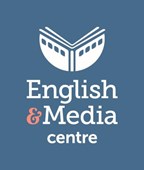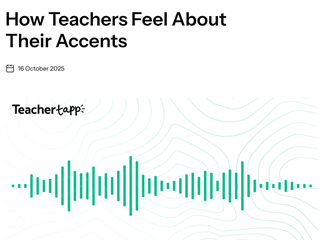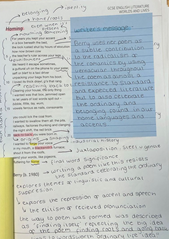Replacing the dominant assessment model
Our last blog unpicked what we called the dominant assessment model in English, which we found to be both anti-disciplinary and, by its nature, anti-assessment. When units of work were driven by end-point assessment pieces, opportunities for genuine formative engagement along the way were limited and the focus was on how students ‘performed’ this assessment piece, rather than on thinking and learning. We wanted to explore the possibilities for learning and formative practice when English teachers stopped using this model. Working with two schools who were also frustrated with the dominant model, we set out to see what happened when lesson time was no longer about building to a single assessment at the end of a unit. This blog outlines the changes these teachers made to their curriculum to make room for different ways of assessing, with formative rather than summative practices prioritised. We set out genuinely interested in how the two schools might approach their work with our research questions in mind:
Research questions
- How does formative assessment work best in English classrooms?
- What is the relationship between formative and summative assessment in English?
Research sub-questions
- What happens when students spend more time reading, writing and editing their work in English?
- What happens when English teachers have time to read and respond to student work?
- What happens when English teachers moderate and standardise KS3 work together regularly?
- Are there barriers to using formative assessment effectively in the English classroom?
- What happens when assessment is removed from the end of a unit of work?
- What happens when a range of student work is used to summarise student attainment in English?
The project schools
The Research & Projects team spent half a term visiting schools around the UK to see the work being done in English classrooms and to understand how different departments carried out KS3 assessment. During these visits, we spent time in English lessons and talked with teachers and curriculum leaders about their practice. Two schools had capacity to work with us further and were selected as the assessment project schools: Kiteford Senior School and John Stone Community School*.
Kiteford Senior School is a large mixed, non-selective state school for 11-18 year olds located in Berkshire. 16% of their students are Pupil Premium, 4% have an EHCP (above the national average) and the school has a specialist provision for students with autism. The majority of students at Kiteford are White British, the rest of the student body is made up of a range of ethnicities, including significant numbers of Pakistani and White (Other) students. 10% speak English as an additional language. In 2023, Progress 8 for English GCSE was 0.08, above the national average.
John Stone Community School is also a large mixed, non-selective state school for 11-18 year olds, located in outer London. 31% of their students are Pupil Premium. Less than 3% have an EHCP (similar to the national average) and the school has a specialist provision for students with autism. The school is ethnically diverse: the largest groups being White British, Black African and Bangladeshi. A third of students speak English as an additional language. In 2023, Progress 8 for English GCSE was 0.26, above the national average.
We started the project by meeting each lead teacher separately: at Kiteford this was James, the Head of English and at John Stone this was the KS3 coordinator, Chloe. In the meetings, the teachers explained their KS3 assessment systems and how they reported as part of whole school data entry, and we shared and discussed some of the reading from our literature review about assessment practices in English, with a strong focus on the link between formative and summative assessment. The challenges of assessment at KS3 at both schools came down to the same tension: where the emphasis was on a summative, end of unit assessment, formative practice was often sacrificed at its expense.
For both schools, it was the research sub question ‘What happens when assessment is removed from the end of a unit of work?’ that they recognised as the catalyst to making important changes that would offer space for a richer curriculum and foreground formative practice. Teachers said constraints and time pressure imposed by summative data collection forced them to choose tasks in the curriculum that prioritised ‘the’ assessment. As we’ve outlined previously, working towards one end-point assessment dominated the focus of their teaching. As one teacher at Kiteford put it:
because of time pressure, and the system itself, and the rules that we have [there’s] such a focus on the outcome that we need to get to. And because of time constraints […] sometimes I feel the pressure to reach a certain point, and you run out of time to do things in between, or you have to choose – do I do this or do I keep moving forward?
Another teacher in the department at Kiteford said:
You teach specific skills to a specific assessment for that data drop and then you lose some of the – and especially at KS3 - some of the actual joy of ‘doing English’.
At John Stone, despite their decision to distance their KS3 end of unit assessments from GCSE-style grades, Chloe reflected that their emphasis on summative data was still distorting the teaching:
I feel like there is still a lot of emphasis placed on that summative assessment...because that grade for us is the one that gets inputted into the data, and the one that goes home to parents...what we’ve been working on this year is that the curriculum and the formative assessment aligns with the summative assessment so that it’s a journey.
Before starting the project, the teachers at John Stone had already been thinking about the question of formative assessment for English, but they wanted to do more – and better – for their students. The lead teacher said in our initial meeting:
There’s lots of ways of assessing formatively that we don’t currently employ... in order to get that summative assessment, sometimes... say it’s an analysis assessment at the end, we haven’t been doing things like, creative writing to help them understand the text, or different modes of assessment that might help us to see their ideas...so there’s less of a range within the schemes themselves.
In other words, the fact they were writing an essay for the end of unit assessment was determining the work that would be done during the unit, rather than acting as a means of checking on the learning and teaching that had been done. Like Kiteford, they were facing the ‘tail wagging the dog’ problem with assessment and curriculum.
Kiteford Senior School
Kiteford's curriculum, which covered a range of novels, drama, poetry, fiction and non-fiction, was under development when we began working with them. James explained that they had a reading or writing assessment at the end of each KS3 unit, except for a Year 8 media unit where students created a portfolio of creative tasks completed throughout. They also included a speaking and listening element in some reading assessments. He said:
Most of our units at the moment are ... either a set of paragraphs... or some kind of extended writing piece, whether that’s transactional or narrative or descriptive, assessed by means of success criteria, and best fit descriptors.
At KS3 they reported using numerical grades 8-1, but these didn’t correlate to GCSE grades and the teacher admitted that this system could be confusing for students and parents and was ‘probably not fully understood by all teachers’. He said
it’s similar to 9-1...but it apparently doesn’t mean that if they’re on a 7 in Year 9 that it’s a pathway to a 7 at GCSE […] it isn’t meant to represent progression.
When reporting KS3 progress to parents/carers, teachers took an average of students’ reading and writing assessments from that term. Reporting happened three times a year. This meant that their grade for each term was based on an average of two pieces of work.
Kiteford ran the project with their Year 9 cohort. The unit for the project was a scheme on rhetoric and was delivered by 11 teachers to 9 classes over a 10-week period. The unit was new and was planned with the project in mind. This offered an opportunity for teachers to plan what the curriculum overview might look like without the need to gear up to a final assessment piece. The department worked with EMC’s Research and Projects team to develop a scheme that aimed to focus on formative practice. Working together, the teachers came up with this proposal, alongside a week-by-week overview:
Objectives/Outcomes
- To demonstrate how rhetoric may be used across a wide range of text forms
- To empower students to recognise rhetorical devices and understand how and why they are being employed
- To show students how texts are used to spread ideas and to change minds
- To equip students with rhetorical tools for use in their own persuasive writing and speaking
Extended pieces of work in the unit
- Textual transformation – speech to poem/song (I have a dream)
- A performance of an existing speech (based on choice of several – film speeches)
- Written evaluation of the success of an existing rhetorical text – could be any of these speeches/ texts
- TED Talk style speech writing – on an issue of their choice
The variety of texts that students would read and engage with, the range of things they would do with those texts and the ways they would respond to them were varied and exciting. Rather than reading speeches and writing analytical paragraphs about them (in the style of the school’s usual ‘reading’ assessment) or writing a speech at the end of the unit (for a ‘writing’ assessment as before), there would be multiple opportunities for students to respond to rhetoric in different forms throughout the unit.
With an emphasis on formative practice, teachers would move through the unit responsively – giving students time to edit and redraft their work and planning and adapting the curriculum accordingly. There would be plenty of time for students to read and respond to each other's work as well. It was important for the focus to be brought back to the formative practice happening in the classroom because that was when students would be meaningfully ‘doing English’ (as one of the teachers put it). Reporting was still required by the school, so teachers would make a summative judgement about students’ work.
John Stone Community School
At KS3, students at John Stone studied a range of units including, novels, 20th century drama, Shakespeare, and transactional and imaginative writing – with at least one unit a year focusing on speaking and listening (for example, a speech or poetry performance). Their curriculum was also under development as the project began. Like Kiteford, John Stone had a reading or writing assessment at the end of each KS3 unit in the form a piece of creative or narrative writing, or an essay. They didn’t use numerical grades to track progress, giving them the freedom to create their own labels for progress: when reporting home, they used the terms ‘foundation’, ‘emerging’, ‘developing’, ‘secure’ or ‘excelling’, which were assigned according to descriptors designed for each unit. These labels were used across departments at the school.
John Stone ran the project with their Year 7 cohort, who were going to study a short stories unit. After our initial meeting, the lead teacher took ownership of the unit and our research questions, and we were invited back to their moderation session after the unit had been taught. The unit was structured around the repetition of a particular sequence for each short story: students read, discussed and explored a short story, then explored a teacher transformation of the story, and finally planned and wrote their own story, inspired by the original. After students read each story, they were introduced to a structure to help them craft their own creative responses. What was striking was how, in each sequence, what the students would be writing was different, according to the content and development of the original text. The students were not being taught criteria focusing on techniques for writing short stories but how to notice and experiment with the features of short story writing that were foregrounded in the specific examples. This often focused on bigger stylistic and structural aspects. Students would be shown how short stories vary, and the potential of the form, expanding their understanding of both reading short stories and writing them. Here are two examples:
After ‘The Necklace’ by Guy de Maupassant
1. Introduce characters, introduce the problem
2. The object of desire
3. Earning it
4. What happens?
5. What is the resolution?
After ‘The End of Something’ by Ernest Hemingway
1. Setting: Becontree - specific places
2. Memory - can I suggest the sadness, the way things used to be?
3. From the story: what's the matter? // I don't know
4. Saying a lot by saying a little: Go on and say it// It isn't fun any more
5. Creating a sad atmosphere. Ending: seeing others who knew
What happened next?
So what conclusions can we draw from this different approach? What kind of work did it produce? How did it change teaching and what teachers were able to find out about their students? What did students make of it? In the blogs to come, you’ll find out what happened during and after the project in the two schools and what the teachers discovered about the potential of formative assessment when they stepped away from the dominant assessment model.
For now, we’ll leave you with this remark from Chloe at John Stone, hinting at the possibilities this approach offered students:
It might help them to think something that we naturally want to instil in the minds of English students: that everything is a work in progress.
*The names of the schools and teachers involved have been changed for confidentiality purposes.




